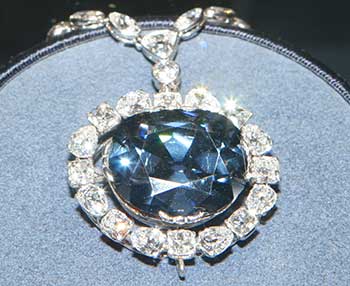 |
| The Hope Diamond. |
Description
The Hope Diamond is an extremely large gem measuring 1 inch long, 7/8 inch wide, 12 mm thick, and weighs approximately 45.5 carats. It was described in 1996 as "fancy deep grayish-blue." It's deep blue color is achieved because of small traces of boron mixed into the molecular structure of the diamond. Under an ultra-violet light it shines in a brilliant red color. It's cut in an antique cushion cut. Until recently it was encased in a platinum setting with 16 alternating pear and cushion cut diamonds, and hung at the end of a chain of 45 diamonds.
History
It is not entirely certain when the Hope Diamond was discovered but it was probably found at the Kollur Mine in India. A french merchant, Jean-Baptiste Tavernier, obtained the gem on one of his trips to India and later sold it to the french King Louis XIV in 1668. At the time it was called the Tavernier Blue and weighed 112 carats. It was re-cut to about 67 carats in 1673 and became known as the French Blue. In 1749 King Louis XV set the diamond into a jeweled pendant for the "Order of the Golden Fleece" to be worn only by the King. It is unknown what happened to it during the French Revolution. Thieves might have stolen it along with most of the Crown Jewels. While several other Order of the Golden Fleece pieces were recovered the French Blue was not among them. It was not entirely certain, until recently, whether or not the French Blue and the Hope Diamond were the same. However, a leaden model of the French Blue was rediscovered in the archives of the French Natural History Museum in Paris. Although cut slightly differently their core features were identical and the Smithsonian published in 2005 that the two were one and the same.The gem then probably came into the possession of Daniel Eliason, a London merchant, and the diamond was cut to its modern shape. It then disappeared again until 1820 when a diamond matching the description and cut of the Hope Diamond was bought by King George IV. At the king's death in 1830 it was bought by banker Henry Philip Hope after whom the diamond was named. From there, the jewel passed through several hands until it was bought by New York jeweler Harry Winston. Winston then donated the diamond on November 10, 1958 to the Smithsonian Institution where it remains today as the most popular gem on display. Its current setting was designed by Pierre Cartier, one of the diamond's owners, in 1920.
The Curse
One of the reasons that the Hope Diamond has become so popular is due to the alleged "curse" that was placed upon it. This legend was most likely spawned by the novel The Moonstone by Wilie Collins in 1868. The novel describes the diamond as being stolen from a Hindu idol by Tavernier, the french merchant, and a curse was laid on it by Hindu priests. The novel claims Tavernier died soon after and his body torn by wolves, but history states that he lived to be 84. The novel also linked the diamond to the deaths of other characters from France and England such as the beheading of Marie Antoinette.In 1904 Olive Muriel Thompson married Lord Francis Hope one of the owners of the Hope Diamond, but she tragically died 8 years later, an event thought to be related to the curse. The Actress May Yohe, former wife of the last Hope to own the diamond, blamed it for her own misfortunes. In 1920 she promoted a 15-episode seriel The Hope Diamond Mystery with her as the star. The serial can not be taken seriously however, as many of its characters and plot points are fictitious.
On January 19 1908 an article entitled, "Hope Diamond Has Brought Trouble To All Who Have Owned It" was published in the Washington Post. In November of 1909 another article was released in the New York Times claiming that the former owner of the gem, Selim Habib, had died in a shipwreck near Singapore. However, this was proven false as the drowned man was simply another man with the same name, and not the former owner. At the time, its current owner, Pierre Cartier, encouraged these tales to interest Evalyn Walsh McLean into purchasing it. Apparently McLean had told him that she thought objects that gave bad luck to others gave good luck to her. McLean bought the Hope Diamond in 1910, and encouraged the stories of its curse for her own publicity. She wore it everywhere she went. However, since the diamond came into the possession of the Smithsonian Institution in 1958 there have been no incidents out of the ordinary.